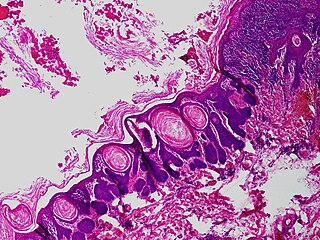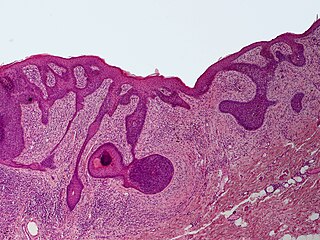Related Research Articles

Hidrocystoma is an adenoma of the sweat glands.
Erythema gyratum repens is a figurate erythema that is rapidly moving and usually a marker of underlying cancer, usually from the lung.
Tuberculosis cutis orificialis is a form of cutaneous tuberculosis that occurs at the mucocutaneous borders of the nose, mouth, anus, urinary meatus, and vagina, and on the mucous membrane of the mouth or tongue.
Lichen myxedematosus is a group of cutaneous disorders considered mucinoses. Conditions included in this group are:
Parakeratosis pustulosa is a cutaneous condition which is exclusively seen in children, usually involving one finger, most commonly the thumb or index finger, with the affected nail showing subungual hyperkeratosis and onycholysis.
Paraneoplastic acrokeratosis, or Bazex syndrome is a cutaneous condition characterized by psoriasiform changes of hands, feet, ears, and nose, with involvement of the nails and periungual tissues being characteristic and indistinguishable from psoriatic nails. The condition is associated with carcinomas of the upper aerodigestive tract.

Koenen's tumor is a cutaneous condition that results in fifty percent of tuberous sclerosis cases.It can be subungual too.
Cutaneous actinomycosis is a chronic disease that affects the deep subcutaneous tissue of the skin. Caused by an anaerobic, Gram-positive, filamentous type of bacteria in the genus Actinomyces, invasion of the soft tissue leads to the formation of abnormal channels leading to the skin surface that discharge pale yellow sulfur granules.

Cutaneous lymphoid hyperplasia refers to a groups of benign cutaneous disorders characterized by collections of lymphocytes, macrophages, and dendritic cells in the skin. Conditions included in this groups are:

Trichofolliculoma is a cutaneous condition characterized by a benign, highly structured tumor of the pilosebaceous unit.

Trichilemmoma is a benign cutaneous neoplasm that shows differentiation toward cells of the outer root sheath. The lesion is often seen in the face and neck region. Multifocal occurrence is associated with Cowden syndrome, in which hamartomatous intestinal polyposis is seen in conjunction with multiple tricholemmoma lesions.
A trichodiscoma is a cutaneous condition, a benign, usually skin-colored tumor most often affecting the face and upper trunk.

A trichoadenoma is a cutaneous condition characterized by a solitary, rapidly growing skin lesion ranging from 3 to 15mm in diameter.

Proliferating trichilemmal cysts are a cutaneous condition characterized by proliferations of squamous cells forming scroll-like structures.
Median raphe cysts are a cutaneous condition of the penis due to developmental defects near the glans.

Perifollicular fibroma is a cutaneous condition, a benign tumor usually skin colored, most often affecting the face and upper trunk.
Sarcoidosis, an inflammatory disease, involves the skin in about 25% of patients. The most common lesions are erythema nodosum, plaques, maculopapular eruptions, subcutaneous nodules, and lupus pernio. Treatment is not required, since the lesions usually resolve spontaneously in two to four weeks. Although it may be disfiguring, cutaneous sarcoidosis rarely causes major problems.
References
- 1 2 Rapini, Ronald P.; Bolognia, Jean L.; Jorizzo, Joseph L. (2007). Dermatology: 2-Volume Set. St. Louis: Mosby. ISBN 1-4160-2999-0.
- ↑ James, William D.; Berger, Timothy G.; et al. (2006). Andrews' Diseases of the Skin: Clinical Dermatology. Saunders Elsevier. ISBN 0-7216-2921-0.
| This Epidermal nevi, neoplasms, cysts article is a stub. You can help Wikipedia by expanding it. |